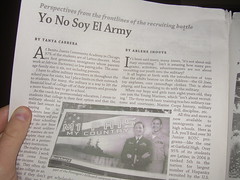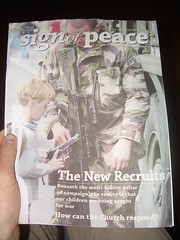The latest issue of the Catholic Peace Fellowship‘s journal, The Sign of Peace, is excellent. You may wish to download the PDF. The CPF would also be delighted to mail you copies.
There follow some passages which caught my interest.
Catholics and Muslims: The Future of an Alliance
In the face of this, what can ordinary Catholics like us do to promote solidarity and reconciliation? How can we work toward the alliance of Catholics and Muslims that seems vital to peace? […]
First, we can continue the Christian critique of violence on theological grounds. […]
Second, we can offer concrete support to Muslims who are in fact working for justice through nonviolent means. One such group is the Muslim Peacemaker Teams (MPT). […]
Finally, in our local communities, we can show Muslims what our faith, at its best, looks like. We can do this by acting together with Muslims on local issues, and asking them to help us in our own need; there are few better ways to forge bonds with people than to ask them for help and to listen to them.
Christ’s Centurion, by Nate Wildermuth
We were killers, everyone knew that. A Ranger would take his bayonet, stick it in your throat, twist, pull, plunge again, and then piss in your face as you drowned in blood. If America needed someone dead, anyone dead, it’d call us. And we’d do it. We’d hop in an airplane, spend 14 hours chanting about napalming churches and machine-gunning nuns, and then we’d jump out, land, pull out our bayonets, and start to kill. And then we’d come home with medals and laugh and laugh and… and now I was at West Point, and I was going to lead others in wars that I had only dreamt about. I would become a Green Berets officer, and I’d fight for their motto – De Oppresso Liber: “to free the oppressed.†I would kill, yes. I would train others to kill, yes. But I would serve, and I would free those in darkness.
(Also posted at Nate’s blog, where you can comment.)
Counter-recruitment and the Church, by the CPF Staff
Imagine first one young person, then another, and another, and at length at deluge of recruits clamoring to join the militia Christi. Imagine, as our counter-recruitment efforts take effect, that young people elect to serve abroad, not in the Army, Navy, Air Force or Marines, but with the Maryknoll Sisters, the Columbans, the Jesuits, Christian Peacemaker Teams. Imagine more and more young people thinking of “the service†in terms of living at Catholic Worker houses and L’Arche communities. Imagine the monasteries and the friaries slowly filling up again.
Eighteen: The Psychology of Enlistment, by Darcia Narvaez, PhD
This one seems to propose a shift in the status of 18-year-olds:
In the human brain, several key systems are underdeveloped until the mid-twenties. In males, full decision-making systems are not developmentally complete until about age twenty-five, and a little earlier for females. Many in society have begun to recognize this reality: car insurance is higher for those under twenty-five; many life decisions like marriage are being pushed to a later age. For the military, however, eighteen has remained the magic number.
An Army of Juan? by Titus Peachey
A few months ago a kind commenter on this blog wrote:
African-Americans, for example, are slightly underrepresented in combat roles.
In “An Army of Juan”, Titus Peachey notes:
For 20 years (1983 to 2003), African Americans consistently made up 21% of all military personnel, even though their share of the total population was only 14%.
[…]
In recent years, as U.S. casualties in the Iraq and Afghanistan wars continue to mount, the enlistment of African Americans has declined dramatically. African American enlistments in the Army have dropped from 22% to 14% over the past four years.
This makes me wonder if it’s only since this crash in military representation that blacks have been “slightly underrepresented in combat roles.”
“Tanya Cabrera and Arlene Inouye share insights from the front lines of the recruiting battle in Latino schools and neighborhoods.”
Illustrated with a photo by Mike Benedetti.

The story of his first encounter with John Hersey’s Hiroshima. If you like this essay, you’ll like his new book A Good War Is Hard to Find, which I hope to write about soon in this space.
I was in the throes of puberty—painful zits and awkward crushes, but no sense that the world was unjust—but Hersey’s first-hand observations, the cold objective details of the aftermath, awoke a deep fascination in me, a curiosity to know why and how it was that human beings could unleash such cruel power on other human beings.
